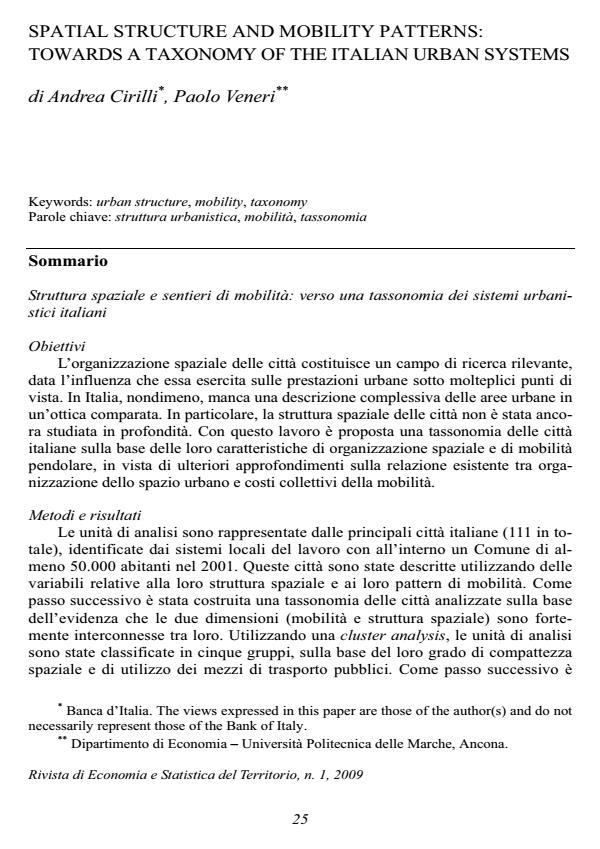Spatial structure and mobility patterns: towards a taxonomy of the Italian urban systems
Titolo Rivista RIVISTA DI ECONOMIA E STATISTICA DEL TERRITORIO
Autori/Curatori Andrea Cirilli, Paolo Veneri
Anno di pubblicazione 2009 Fascicolo 2009/1
Lingua Inglese Numero pagine 38 P. 25-62 Dimensione file 185 KB
DOI 10.3280/REST2009-001003
Il DOI è il codice a barre della proprietà intellettuale: per saperne di più
clicca qui
Qui sotto puoi vedere in anteprima la prima pagina di questo articolo.
Se questo articolo ti interessa, lo puoi acquistare (e scaricare in formato pdf) seguendo le facili indicazioni per acquistare il download credit. Acquista Download Credits per scaricare questo Articolo in formato PDF

FrancoAngeli è membro della Publishers International Linking Association, Inc (PILA)associazione indipendente e non profit per facilitare (attraverso i servizi tecnologici implementati da CrossRef.org) l’accesso degli studiosi ai contenuti digitali nelle pubblicazioni professionali e scientifiche
Spatial structure and mobility patterns: towards a taxonomy of the Italian urban systems - Urban spatial organization has become a wide field of research in the last years, since it is thought to be an important determinant of the city’s performance from many points of view. Nevertheless, Italian urban spatial organization has not been studied in depth and a general description of the Italian urban territory is lacking. The aim of this work is to build a taxonomy of the Italian cities where the latter are conceptualised as agglomeration of contiguous municipalities on the basis of their patterns of spatial organization and commuting-to-work mobility. For this purpose, three preliminary steps had to be carried out. First of all, the major Italian urban systems have been identified, following a functional approach that is based on the principle of maximum self-containment of commuters’ flows. Secondly, original indicators have been built to gain a better understanding of cities’ spatial organization and of their patterns of mobility. Thirdly, the relation between these two dimensions has been investigated through a multivariate statistical analysis. The results of the analysis show that variables of spatial organization especially urban dispersion and of mobility patterns are closely related and that cities might be aggregated in five groups, ranging from the most compact and transitoriented cities to the most dispersed and car-oriented ones.
- De la forme urbaine à la structure métropolitaine : une typologie de la configuration interne des densités pour les principales métropoles européennes de l’Audit Urbain Florent Le Néchet, in Cybergeo /2015
DOI: 10.4000/cybergeo.26753 - Unnatural sprawl: Reconsidering public responsibility for suburban development in Italy, and the desirability and possibility of changing the rules of the game Stefano Moroni, Luca Minola, in Land Use Policy /2019 pp.104
DOI: 10.1016/j.landusepol.2019.04.032 - Urban form and daily mobility on the outskirts of Constantine (Algeria): Case of the new town of Ali Mendjeli Imane Benhenni, Djamel Alkama, in Glasnik Srpskog geografskog drustva /2024 pp.207
DOI: 10.2298/GSGD2401207B - Modelling the impact of urban form on daily mobility energy consumption using archetypal cities Maud Haffner, Olivier Bonin, Gilles Vuidel, in Environment and Planning B: Urban Analytics and City Science /2024 pp.870
DOI: 10.1177/23998083231206169 - Approche multiscalaire de la mobilité domicile-travail en Île-de-France et dans la région Rhin-Ruhr Florent Le Néchet, in Cahiers de géographie du Québec /2013 pp.405
DOI: 10.7202/1014553ar
Andrea Cirilli, Paolo Veneri, Spatial structure and mobility patterns: towards a taxonomy of the Italian urban systems in "RIVISTA DI ECONOMIA E STATISTICA DEL TERRITORIO" 1/2009, pp 25-62, DOI: 10.3280/REST2009-001003